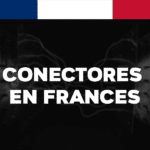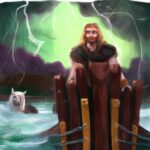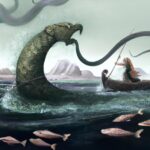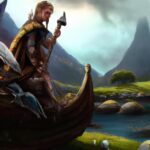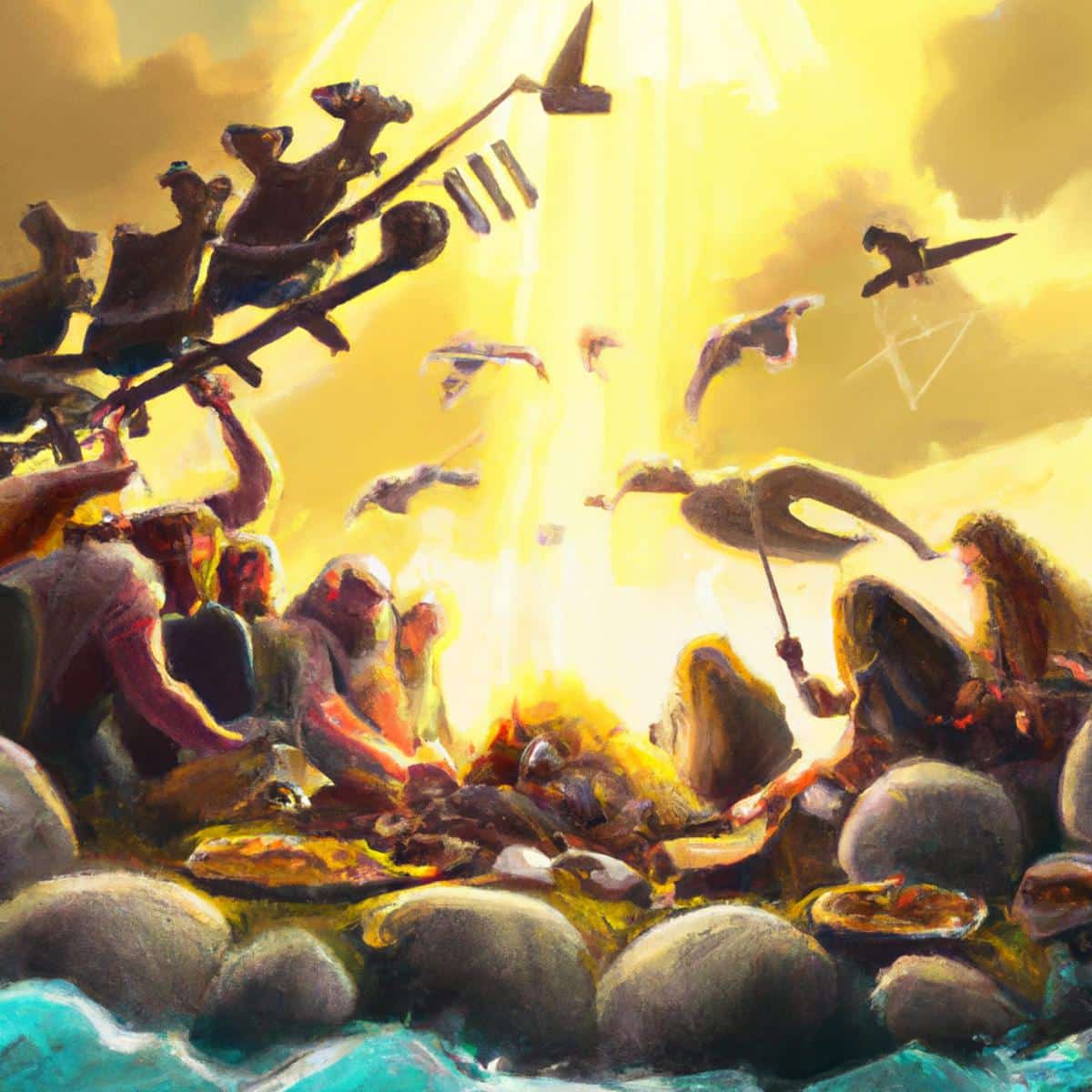
The Feast of the Gods is a masterpiece of Italian Renaissance painting created by the Florentine artist Sandro Botticelli between 1482 and 1483. It is located in the Uffizi Gallery in Florence, Italy. It is painted with oil on canvas and measures approximately 5 meters by 3 meters. The work represents an episode from the epic poem The Odyssey, written by Homer in the XNUMXth century BC. C., which describes a banquet offered by the immortal gods to celebrate Achilles' victory over Troy.
In this work, the gods can be seen gathered around a great banquet on Olympus, seated on golden thrones and surrounded by ornate columns and arches. The main characters include Zeus (the father of all gods), Hera (Zeus's wife), Poseidon (the god of the sea), and Aphrodite (the goddess of love). The background is made up of natural landscapes such as mountains, rivers and forests that surround Olympus. The painting also contains various mythological figures such as centaurs, mermaids, and even the winged horse Pegasus flying above the clouds.
The Feast of the Gods is considered a perfect example of the Italian Renaissance artistic style characterized by its detailed realism, vibrant coloring, and balanced composition. It is filled with religious and historical symbolism that reflects classical ancient Greek culture as well as modern European medieval Christian beliefs. The work has become an iconic symbol for Florence for centuries due to its unique and timeless artistic beauty that has inspired subsequent generations to this day.
Summary
The Feast of the Gods is a Norse tradition that dates back to ancient times. This celebration was carried out to honor the gods and ask for their blessing. The feast consisted of a banquet attended by all the gods, including some human guests. During the banquet, the guests enjoyed food and drink, music and dance, as well as telling stories and exchanging gifts.
During the Feast of the Gods, sacred rituals were also performed to honor the gods and ask for their blessings. These ceremonies included food and drink offerings, animal or human sacrifices, prayers, and magical invocations. Sometimes games or competitions were also held among attendees to see who was the best in each discipline.
The Feast of the Gods was an important event for Norse culture as it represented the connection between the divine and human worlds. The gods were revered for their power and wisdom, while people received their blessing to prosper in their earthly lives. In addition to the spiritual significance of the event, it was also an opportunity to meet with distant family and friends and exchange news about what was happening in other parts of the Nordic world.
Main characters
The Feast of the Gods is one of the most famous legends in Norse mythology. This story tells of the arrival of the god Odin and his companions at the house of the giant Baugi, in search of a banquet for the gods.
Baugi was the younger brother of the giant Suttung, who had stolen the sacred mead that contained all the knowledge and wisdom in the world. Odin found out about this and decided to go retrieve it for the gods. When they arrived at Baugi's house, he offered them a banquet as a reward for his help in retrieving the sacred mead.
The gods sat around the table and began to eat and drink until there was nothing left on the table. The dishes served included roast meat, sweet breads, fresh fruits, sweet wine, and strong beer. After eating their fill, the gods were so satisfied that they decided to stay there for three days to celebrate their success in retrieving the mead sacred to the gods. During this time they sang ancient songs praising Odin for his feat and toasting his success with goblets filled to the brim with wine or strong beer. At the end of these three days they returned triumphantly to Asgard with the sacred mead in their custody.
The Feast of the Gods is an important story in Norse mythology as it shows us how Odin was able to achieve the unthinkable: steal the precious sacred mead from the giant Suttung without being discovered or losing it on the way to Asgard. This story also shows us how important it was for the ancient Norsemen to celebrate their achievements with large banquets filled with delicious food, good drink and ancient songs sung among friends to honor those who made such a feat possible.
intervening gods
The Feast of the Gods is one of the main celebrations in Norse mythology. This is an annual festival in which the gods come together to share food and drink, as well as to tell stories and sing songs. This party is celebrated in the hall of Valhalla, the place where the heroes fallen in battle are taken by the Valkyries.
The main gods participating in the Feast are Odin, Thor, Freya and Heimdall. There are also other lesser gods present like Loki, Bragi and Idun. During the celebration, each of them shares their exploits with the other guests while enjoying food and drink served by Freyja and Heimdall. Guests also enjoy entertainment provided by Bragi, who plays his magical harp and performs ancient songs about the epic adventures of the Norse gods.
In addition to the musical entertainment provided by Bragi during the feast, there are also fun games that everyone can enjoy together. These include games like hammer throwing (Thor), races (Odin), and even poetic contests (Bragi). At the end of the party, everyone says goodbye with a joyous toast before returning to their respective homes to prepare for another big celebration the following year.
Main topics covered
The Feast of the Gods is an ancient and mythical celebration that dates back to Norse mythology. It is a sacred banquet where the gods come together to share food, drink and entertainment. The banquet was first described in the Edda Poem, a collection of Scandinavian poems written between the XNUMXth and XNUMXth centuries.
According to legend, the Feast of the Gods took place in Asgard, the heavenly city where the Norse gods lived. The guests included all the main gods of the Norse pantheon: Odin, Thor, Freya and Loki among others. The banquet was hosted by Freyja, the goddess of love and fertility. During the feast, delicacies such as roast wild boar meat with spicy sauce and freshly baked bread made with fine flour were served. The favorite drink was mead (a mixture of water and fermented honey).
In addition to the delicious treat, there were also many fun activities to enjoy during the feast. The gods played games like dice or cards; they sang songs; they danced around the fire; they would tell stories and even perform physical challenges like wrestling or running races. These activities helped keep the competitive spirit alive among themselves and also allowed them to relax after a long day working to maintain order in Asgard.
The Feast of the Gods is an important cultural symbol within Norse folklore as it represents the central idea behind the Viking concept: sharing good food with good friends while celebrating life together. This tradition is still honored today during modern celebrations such as weddings or family gatherings where traditional dishes are served alongside alcoholic beverages to remember this ancient pagan custom.
